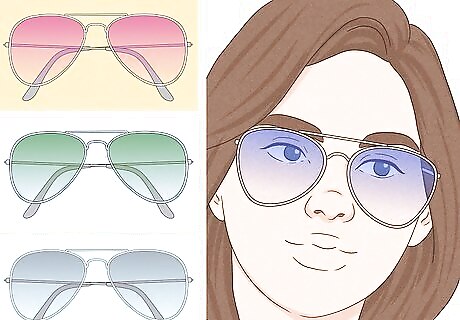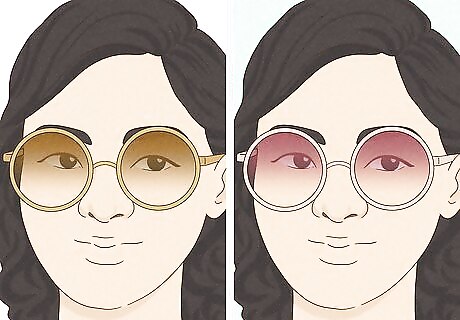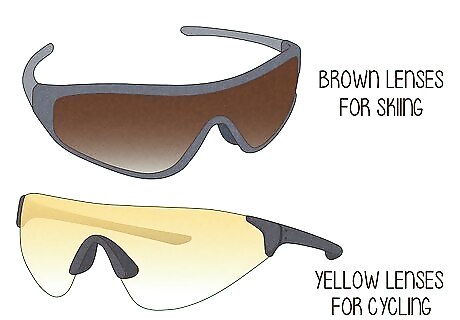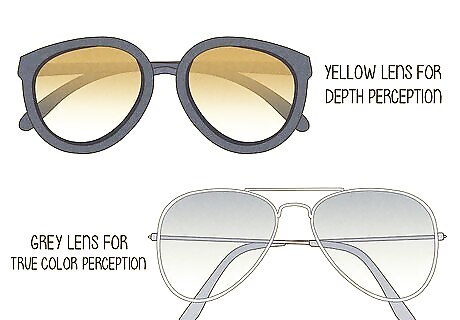
views
X
Expert Source
Sarah McDonaldCertified Stylist & Image Consultant
Expert Interview. 26 August 2021.
Ready to find the perfect pair? Read on!
Picking the Right Frame Color

Pick green, purple, blue, pink, or silver frames if you have a cool skin tone. To determine if you have a cool skin tone, check these factors: if you burn easily, have blue veins (instead of green), and blue, green, or gray eyes, you have a cool skin color. Pick a frame that matches that skin tone. If you have a mix of warm and cool skin tone features, you're considered neutral and can wear either set of colors.

Try red, brown, beige, orange, gold, or yellow frames for a warm skin tone. To check to see if your skin is a warm tone, consider these factors: if your tan easily, have veins that are green (instead of blue), and hazel, black, or brown eyes, you have a warm skin tone.

Choose dark colored frames for fair skin tones but avoid black. Black can be too dark if you're fair-skinned. If you want to go dark, try a dark wood frame, such as mahogany. Alternatively, reach for a pair of tortoiseshell frames. These frames will give you the dark color you crave without overwhelming your skin tone.

Choose nude for every skin tone. Nude is a classic shade, no matter what your skin tone. It brightens up your face, giving it a glow. Plus, it looks good with almost any outfit, so you never have to worry about a mismatch.

Try mid-tones to bring out the warmth in your skin. No matter what your skin tone, colors in the mid-range can help add warmth and color. If you're feeling a little pale or it's just mid-winter, try choosing this option. Mid-tone colors are softer than "bright" colors but not as soft as pastels. Try periwinkle, olive, or rose-colored mid-tone sunglasses.

Opt for natural colors over neons. Kids can get away with neon glasses, but if you're going for a more sophisticated look, you need to choose a more sophisticated color. Try natural tones like tan or caramel. For a more colorful look, try a merlot or rich, dark green.

Pick dark colors if you have dark hair. Dark colors also do well for people who have dark hair. The dark colors of the glasses will naturally draw out the loveliness of your hair color, creating a sophisticated look. Similarly, light colors often go well with people who have lighter hair.
Choosing the Right Lens Color

Try blues, pinks, greens, and silvers for a cool skin tone. These colors will go best with your complexion and eye color, as you have green, blue, or gray eyes with a cool skin tone. You'll also have blue veins on your arm, and you burn easily.

Pick fiery colors or browns for a warm skin tone. Your lenses will blend perfectly with your skin if you choose colors in these ranges. Keep in mind, you have a warm skin tone if you tan well, have brown, black, or hazel eyes, and have green veins on your arms.

Opt for the right color to set a mood. While matching to your skin tone is important, it's also a good idea to let your lenses help set the mood. For instance, a light tan lens is sophisticated, while a rose lens creates a soft mood.

Choose the appropriate lens for the activity. Different colored lens also helps with specific activities. For instance, if you're planning to ski, opt for brown lenses, as they can help you see contrast better, which is helpful on the snow. Yellow also assists with contrast, which can assist in activities such as bicycling.

Pick lenses based on what you need to see. If depth perception is important to you, choose a yellow lens. If you need to see color well, choose a grey lens, as it allows the truest color perception.
Picking Protective Sunglasses

Opt for UV-protected sunglasses. To protect your eyes, your sunglasses need to be rated to block out 99 percent of UV rays. The tag that comes with the sunglasses should specifically state how much the sunglasses block out. If it doesn't list the UV rating, you should skip that pair. If you don't wear protective sunglasses, you can develop eye cancer from the sun's rays over time.

Choose larger sunglasses for more protection. When it comes to eye protection, larger is better. Larger sunglasses provide more protection for your skin and eyes, so pick large lenses. Wrap-around sunglasses are also a good idea.

Make sure your sunglasses fit. If your sunglasses are constantly slipping down your nose, then they aren't doing a good job of protecting your skin and eyes. Make sure any glasses you choose rest snugly on your nose and ears.

Remember that polarization doesn't block sun rays. It can be confusing to shop for sunglasses, especially with words like "polarization" floating around. However, while polarization can help with glare, it won't provide protection from the sun's UV rays.



















Comments
0 comment